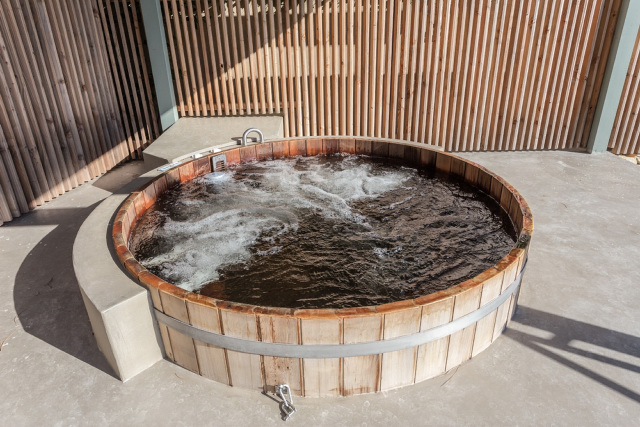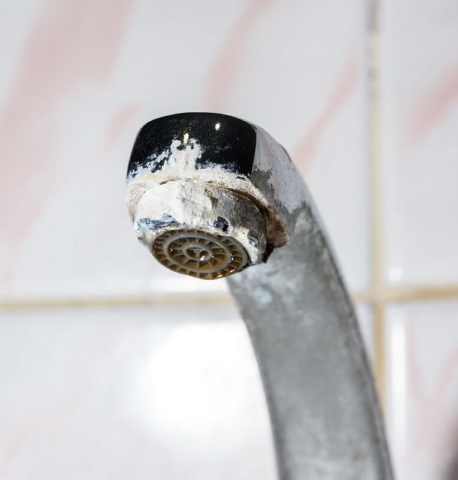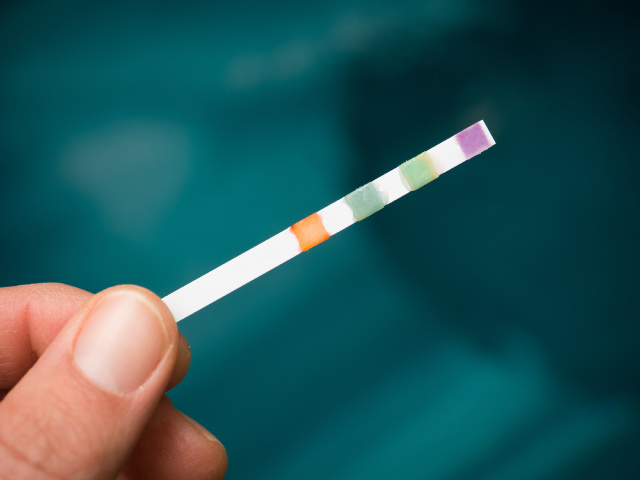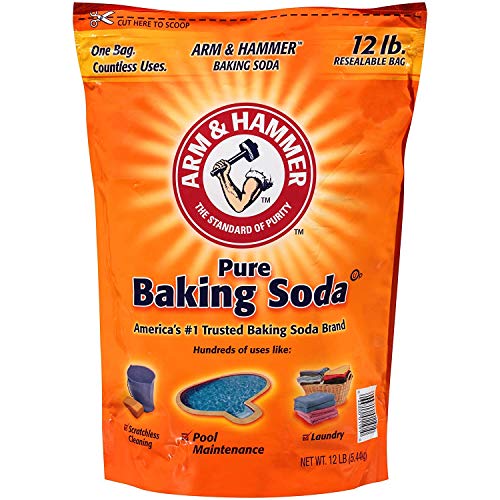So, you might’ve just tested your hot tub water and noticed that the pH was too high. Luckily, there are several ways you can go about lowering that pH down to normal, which is what we’ll be going over today in this article.
The most common ways to lower pH in a hot tub are to either add muriatic acid or sodium bisulfate to the water. Both have their pros and cons to consider, however, they’re both effective in lowering the pH. Whichever one you choose will depend on your considerations.
Before we tackle the issue of lowering the pH, let’s first take a look at what exactly having a high pH means. We’ll also look at the problems caused by high pH so that you can take the proper prevention measures in the future.

Article Contents
When Hot Tub pH Considered High?
pH is a number (between 0 and 14) that you can use as a reference to determine whether something is acidic or basic. The lower or higher the pH is, the more acidic or basic something is respectively. A high pH is when you have a pH level above a certain, normal threshold for your hot tub.
When is Hot Tub pH Considered High?
The pH of your hot tub is considered high if it’s above 7.6. Anything above this will eventually cause issues with your water chemistry and physical changes as well.
What Causes High pH in Hot Tubs?
The typical suspects when it comes to having a high pH in your hot tub include aeration, low total alkalinity, the water source, and a miscalculation of chemicals.
1. Aeration (Outgassing)
Aeration is when there is a disturbance in the water (through any kind of physical activity) that causes air to enter the water. In hot tubs, it’s when the jets or bubbles are on.
When this happens, the excess air will cause the release of carbon dioxide in the water (known as outgassing). Because the carbon dioxide is acidic, the loss of it means the water’s pH will rise.
2. Incorrect Total Alkalinity Level
Total alkalinity is the ability of your hot tub’s water to neutralize acids. The typical range of alkalinity in a standard hot tub is between 80 and 120 ppm.
Because the alkalinity acts as a buffer against pH changes, once you have an alkalinity level outside the normal range, you’ll encounter larger pH swings that can cause it to rise above its optimal range.
3. Water Source
The pH of the water can depend significantly on the source of the water for your hot tub. For example, if you’re receiving water from a surface water well or groundwater system, the water can have a pH ranging anywhere from 6 to 8.5. Sometimes, the issue can be as simple as where you’re getting the water from.
4. Miscalculated Amount of Chemicals Needed
There are several chemicals out there that are used to raise alkalinity, which, if used in the wrong proportions, can cause your pH to increase to dangerous levels.
Both baking soda and soda ash are used to raise pH and alkalinity. Soda ash is best suited to raise pH in large steps. As a result, if you perhaps tried to raise the pH or alkalinity levels of your hot tub, you might’ve accidentally added too much of these chemicals and ended up having a higher than expected pH.
Can You Use a Hot Tub with High pH?
Unlike when you have an abnormal alkalinity problem, you should never use your hot tub if you have a higher than normal pH. Either way, once your pH rises above 7.6, you should stop using your hot tub immediately.
What are the Effects of High pH in a Hot Tub?
From cloudy water to skin irritation, there are many reasons why you shouldn’t get into a hot tub when you have high pH levels. Here are the most common problems associated with high hot tub pH:
1. Cloudy Hot Tub Water
Having a high pH will affect how the chemicals in the water interact. As a result, it can cause the water to improperly dissolve calcium, which will easily lead the water to have a hazy appearance instead of its usual clear look.
2. Chlorine Demand Goes Up
High pH levels reduce the effectiveness of chlorine; thus, you’ll need more of it to keep your hot tub properly sanitized. This will eventually cost you both the sanitizer and the water needed to top up your hot tub.
3. Increased Scale in Hot Tub
Another side effect of having high pH is excess calcium. Excess calcium can combine with the carbon dioxide already present in the water to form calcium carbonate. This then becomes a solid that can float on the water surface, as well as coat the walls of your hot tub, and enter the plumbing system.

4. Damaged Hot Tub Equipment
With the combined effects of high pH water and scale buildup, you can quickly find your hot tub equipment being damaged. Because the water and scale can enter very small spaces, you may find your pipes, pump, and filter all damaged.
Scale, or calcium deposits, coat the inside of pipes restricting the water flow. Calcium also clogs up heaters.
Usually, if this happens, the only option for you will be to replace these items.
5. Itchy Skin, Irritated Eyes, and Everything in Between
Similar to low pH water, high pH water can also become an irritant to bathers. If you or anyone you know decides to bathe in the high pH water, you’ll quickly notice how your skin and eyes become itchy and irritated. The fumes can also affect your nasal passages, with those having a sensitive respiratory system potentially developing respiratory distress.
Chemicals to Lower pH in Hot Tubs
The best chemicals to use when trying to lower the pH in your hot tub are:
- muriatic acid (diluted hydrochloric acid)
- sodium bisulfate
What is Muriatic Acid?
Muriatic acid is commonly found as a liquid acid (though the dry form exists as well) and is one of the most common solutions when it comes to lowering the pH of a hot tub. It is also a form of hydrochloric acid (albeit a watered-down version).
The biggest benefits of muriatic acid are that it is inexpensive and very effective at lowering the pH quickly as well as getting rid of mold, algae, and calcium buildup.
It is because of how strong of acid it is that it’s also very dangerous to handle, with exposure potentially creating several health issues such as skin burns, eye damage, and respiratory irritation. Considering that it’s usually found in a liquid form means that you’re even more susceptible to its dangers due to the potential for splashing or spilling.
What is Sodium Bisulfate?
Sodium bisulfate (also known as pH down/pH decreaser) is another common chemical that’s used to lower the pH of hot tubs. Unlike muriatic acid, sodium bisulfate is a dry acid that is commonly found in granule form.
The primary benefits of sodium bisulfate are the fact that it’s milder and much less irritating to the body when exposed. This is because it’s both a milder acid and is less prone to accidental exposure (due to it being granules instead of liquid).
However, being a milder acid means that it’s less effective than muriatic acid (it takes a little longer to achieve the same results). It’s also quite a bit more expensive.
Should You Use Muriatic Acid or Sodium Bisulfate?
Muriatic acid costs less and you’ll need less, however, it’s more dangerous to handle and store. Plus if you spill it, it can etch or damage where it contacts.
Sodium bisulfate is safer to store and easier to use with less chance of causing damage to you or your surroundings. However, it is more expensive.
At the end of the day, it’s really up to you to determine which to use based on your priorities. Many hot tub owners do prefer Sodium Bisulfate (pH Down/pH Decreaser).
Related Reading: What Order Should You Add Chemicals in a New Hot Tub? A Hot Tub Start-Up Guide
How to Lower pH in a Hot Tub
At last, we’ll take a look at how exactly you can lower the pH of your hot tub using either muriatic acid or sodium bisulfate.
Lowering pH Using Muriatic Acid or Sodium Bisulfate
Here’s what you’ll need to lower the pH of your hot tub using muriatic acid:
- Liquid test kit/testing strips
- Muriatic acid
- Protective gear (gloves, goggles, mask, chemical apron)
- Bucket
- Wooden/plastic stirrer
Now that you have the necessary materials, let’s see what the procedure’s like:
1. Test the Water
Using a test kit, read and adjust the alkalinity to make sure it’s between 80 to 100 ppm.
Use either a liquid test kit or testing strips to get a reading of the current pH.
2. Put on Safety Gear
Wear long-sleeved clothing, acid-resistant gloves, and safety goggles when handling acids.
3. Calculate and Measure the Dosage
Depending on the product, determine the amount of muriatic acid you’ll need to lower the pH of your hot tub water to between 7.4 and 7.6.
Tip: use half to three-quarters of what you think you need. It’s better to make small adjustments and need to add more. Rather than add too much.
How much muriatic acid do you need? As a general rule, add 0.3 oz to lower the pH 0.1 for 1000 gallons of water. Assuming you’re using 31% strength acid.
How much sodium bisulfate do you need? As a general rule, add 0.3 oz to lower the pH 0.1 for 1000 gallons of water.
4. Dilute and Mix Acid
Dilute the muriatic acid with water in a 1:10 ratio. Add the water first to the bucket before adding the acid. Mix using the stirrer.
Do not use a bucket that has been used to mix other chemicals. It could cause a dangerous reaction,
5. Pour in the Acid
Slowly pour the solution into the hot tub and let the jets aerate it. Place the cover on the hot tub and let the acid circulate overnight.
6. Retest and Repeat if Necessary
Retest the pH and make any necessary adjustments if pH isn’t in the range of 7.4–7.6.

Other Products to Consider
Besides muriatic acid and sodium bisulfate, another pH-lowering product you can potentially try is hydrochloric acid (HCl). Like the other two chemicals, HCl has its pros and cons. Therefore, it’ll ultimately be up to you to determine which solution is right for you.
In simple terms, HCl is muriatic acid albeit a much more potent version. As you might imagine, HCl, as a strong acid, is very powerful. This makes it highly effective at lowering the pH of your hot tub quickly and removing just about anything else floating in the water or coating the equipment.
With great power comes great risks. This is especially true for HCl, which is highly dangerous to handle. All the precautions that you’ll normally take for muriatic acid are heightened to a greater degree here.
Due to the high amount of risks that this chemical carries, it’s best to use muriatic acid or sodium bisulfate.
Will pH in Hot Tub Lower by Itself?
The pH in the water will not lower on its own without any outside intervention. Because the things that are causing the high pH are very much dissolved in the water (sometimes it’s the water itself), they’ll stay the way they are even if you simply let the hot tub sit there.
Can You Use Baking Soda to Lower Hot Tub pH?
Simply put, you could not go more wrong than trying to lower your high pH problem with baking soda. As an alkaline compound, baking soda can only increase the pH of the water. That’s why the choices you have are all acids because only acids have low pHs that can bring down the overall pH of the water.
If you want to raise total alkalinity, use baking soda. Like this one here:
Are There Any Natural Ways of Lowering Hot Tub pH?
There are two natural ways, without the involvement of any chemicals, to lower the pH level of a hot tub:
- Partial draining and refilling
- Vinegar
The most effective of these ways is to either drain some of the water and refill it with fresh water (making sure its pH is within the right range) or add vinegar to the water.
Of the two, draining and refilling the hot tub is the more natural solution as it truly doesn’t involve any additions to the water. However, this process can be difficult as you would need to correct the balance of the chemicals in the water after refilling. This could end up making things worse and can take many tests. It’s also quite time-consuming.
Though not as effective as muriatic acid or sodium bisulfate, vinegar can lower the pH of your hot tub, sanitize your hot tub, and clean it as well. However, because vinegar can make the water smelly and change its color, it’s best to use white vinegar, an acid made using natural grain and water.
Related Reading:
How to Lower Hot Tub pH Naturally (Using Vinegar)
How to Lower the pH in your Pool
How to Reduce pH Level in a Saltwater Swimming Pool
2 Ways to Raise pH in Hot Tub (pH is Low)
Bromine in Hot Tub High | How to Lower Bromine Levels




